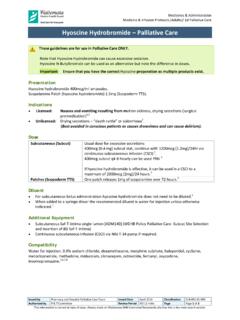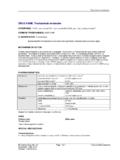Transcription of Palliative Care - Waitematā District Health Board
1 Medicines & Administration Medicines & Infusion Protocols (Adults)/ 1d Palliative Care Dexamethasone - Palliative Care (Adults). Contents 1. Overview .. 1. 2. Presentation .. 1. 3. Indications .. 2. 4. Dose .. 2. 5. Principles of 3. 6. Administration .. 3. Additional Administration Procedure ..4. 7. Observation and Monitoring .. 4. 8. Mechanism of 4. 9. Contraindications and Precautions .. 5. 10. Adverse Effects .. 5. 11. 5. 12. 5. 1. Overv iew Purpose This protocol outlines the administration, prescribing and monitoring of dexamethasone at Waitemata District Health Board .
2 Scope All medical and nursing staff This guideline is for use in Palliative Care ONLY. Caution Steroids are usually for short-term use (3 10 days) in Palliative Care. Consider alternative options to manage chronic symptoms. Consider a reducing dose for patients who have been on dexamethasone for longer than 5 7 days. 2. Presentation Dexamethasone and 4mg tablets Dexamethasone phosphate (as sodium) 4mg in 1ml glass ampoules Dexamethasone phosphate (as sodium) 8mg in 2ml glass ampoules - Dexamethasone injection is a clear, colourless solution Issued by Pharmacy and Hospital Palliative Care Team Issued Date July 2016 Classification 014-001-01-067.
3 Authorised by P&T Committee Review Period 36 mths Page 1 of 6. This information is correct at date of issue. Always check on Waitemata DHB Controlled Documents site that this is the most recent version. Medicines & Administration Medicines & Infusion Protocols (Adults)/ 1d Palliative Care Dexamethasone - Palliative Care (Adults). 3. Indications Licensed: Cerebral oedema (raised intracranial pressure). Therapy for specific diseases including auto-immune, endocrine, pulmonary and blood disorders Treatment of allergy Adjunct treatment for shock 1.
4 Unlicensed: Nerve compression, spinal cord compression, superior vena cava obstruction, obstruction of hollow viscus ( malignant obstruction of bowel or bronchus), bone pain, nausea and vomiting, prevention of inflammation at continuous subcutaneous infusion site, discharge from rectal tumour, paraneoplastic fever, dyspnoea, appetite stimulation, enhance sense of wellbeing, hypercalcaemia, liver capsule stretch pain, symptomatic radiation-induced oedema/inflammation, itch 2, 3, 4. Unlicensed route of administration: subcutaneous 4. Dose Doses can vary according to the individual patient and the indication.
5 2, 3, 4. Note: The oral bioavailability of dexamethasone is 80% therefore the conversion ratio from oral:subcut/IV. is 1:1. 2-4mg/day 4-8mg/day 8-16mg/day - To reduce - Increase appetite Co-analgesic in: Raised intracranial - irritation at - Co-analgesic in some - nerve compression pain pressure due to cerebral the infusion painful conditions - hepatomegaly oedema ( tumour site - General anti-emetic - other painful conditions induced). - Spinal cord compression - Symptomatic radiation- (16 mg daily). induced oedema / - SVC obstruction inflammation - Tumour induced airway - Malignant bowel obstruction obstruction - Malignant bowel obstruction - Prevention of chemo- emesis Note: Consider use of a proton pump inhibitor ( omeprazole) while on dexamethasone 4, 5.
6 Doses higher than 16mg dexamethasone daily are occasionally prescribed on the advice of a relevant Specialist. Issued by Pharmacy and Hospital Palliative Care Team Issued Date July 2016 Classification 014-001-01-067. Authorised by P&T Committee Review Period 36 mths Page 2 of 6. This information is correct at date of issue. Always check on Waitemata DHB Controlled Documents site that this is the most recent version. Medicines & Administration Medicines & Infusion Protocols (Adults)/ 1d Palliative Care Dexamethasone - Palliative Care (Adults).
7 5. Principles of Use The dose needs to be reviewed at least weekly and instructions documented clearly. Adjust dose according to individual response. A dose of daily may have the same effect for one patient as another taking 4mg daily. Consider giving dexamethasone before midday as it may disturb sleep. Doses over 4mg daily are likely to lead to side-effects and should be reduced as soon as possible. Doses less than 4mg daily are often tolerated in someone with a prognosis of months. 4. Reducing dose2, 4. May stop dexamethasone abruptly if used: o at doses up to 4mg daily for less than 3 weeks o at doses up to 12mg daily for no longer than 5-7 days If used for longer or received repeated courses, reduce dose slowly to avoid adrenal insufficiency due to adrenal suppression.
8 Reducing dose slowly also allows time at new level to assess response, especially whether there is any deterioration: o Dexamethasone dose above 4mg daily reduce by 2mg every 5-7 days until reaching 2mg, then by every 5-7 days check for symptoms before each dose reduction o Dexamethasone dose of 4mg or less reduce by every 5-7 days o If rapid reduction required, may reduce dose every 3-4 days 6. Administration Diluent subcutaneous bolus/IV. For subcutaneous bolus / IV administration dexamethasone does not need to be diluted. It is long acting and can be given once daily as a bolus injection.
9 2. Avoid giving more than 2ml (8mg) as single stat subcutaneous dose. Continuous subcutaneous infusion When added to a syringe driver the recommended diluent is water for injection. Sodium chloride should be considered if there is potential for inflammation at the injection site. Dexamethasone should be added last to an already dilute combination of drugs in order to reduce the risk of precipitation. It is advisable to use a 30ml syringe for this purpose. 2. Additional Equipment subcutaneous Saf-T-Intima single lumen [ADM140] (refer WDHB Policy Palliative Care- subcutaneous Site Selection, Insertion and Monitoring of BD Saf-T-Intima Cannula).
10 Continuous subcutaneous infusion pump (Niki T34 ) if required Issued by Pharmacy and Hospital Palliative Care Team Issued Date July 2016 Classification 014-001-01-067. Authorised by P&T Committee Review Period 36 mths Page 3 of 6. This information is correct at date of issue. Always check on Waitemata DHB Controlled Documents site that this is the most recent version. Medicines & Administration Medicines & Infusion Protocols (Adults)/ 1d Palliative Care Dexamethasone - Palliative Care (Adults). Compatibility Compatible with: Water for injection, sodium chloride, morphine sulfate, morphine tartrate, tramadol, methadone, metoclopramide, clonazepam, fentanyl, oxycodone, hyoscine hydrobromide, hyoscine butylbromide 2, 3, 4.
![[P] Midazolam - Palliative Care](/cache/preview/f/d/1/a/9/5/a/e/thumb-fd1a95aeebe3a3a2108377669a11cc07.jpg)
![[P] Fentanyl Subcutaneous & Nasal - Palliative Care (Adults)](/cache/preview/3/6/0/0/a/b/5/9/thumb-3600ab597c837bd6f4f240fa5200c14c.jpg)
![[P] Clonazepam - Palliative Care](/cache/preview/7/3/1/8/c/1/0/f/thumb-7318c10f561f7c7ba618d52f79801a4d.jpg)




